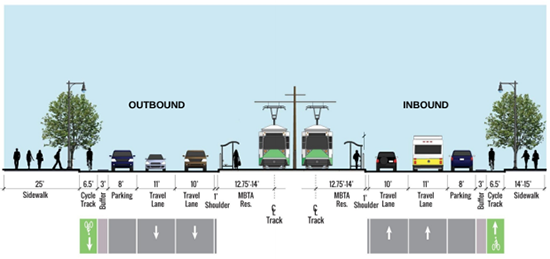Barriers Will Protect Cyclists from Comm Ave Traffic
After years of debate, city's plan pleases bikers

Parked cars will be used as a barrier to protect bicyclists from motorists on Commonwealth Avenue. Photo by Jackie Ricciardi
After years of debate about how to make Commonwealth Avenue safer for cyclists, the city of Boston unveiled a plan Tuesday night to install a barrier that will separate bikers from motorists on the stretch of pavement between Packard’s Corner and the BU Bridge. The 6.5-foot-wide bike lanes on both sides of the avenue will be separated from traffic by a row of parked cars and by 3-foot wide raised buffers between the parked cars and the cyclists. The $17 million project will begin in spring 2016 and is slated for completion by fall 2017.
An elevated crosswalk at the intersection of Comm Ave and St. Paul Street will also slow motor traffic entering that intersection, where cyclist Chris Weigl (COM’13) was killed in 2012. That accident was one of 68 reported bike crashes from 2010 to 2012 along the frenetic strip between the bridge and Packard’s Corner.
In announcing the cycle tracks and scrapping earlier, less protective plans, the city won the approbation of bicycle advocates, many of whom cited the success of tracks in other cities at a public hearing about the matter in December.
“Safety is our first priority, and it is our opinion that a cycle track at this location is the option that will best reduce the number of crashes between motor vehicles and bicycles,” says James Gillooly, a city deputy transportation commissioner. “Advocates brought us their concerns and ideas, we listened and learned from them, and, as a result, the updated design is more progressive than our original plan.” His department would like to see the track extended further along Comm Ave, and “we plan to advocate for that in time,” he adds.
Michelle Consalvo, assistant vice president for government and community affairs, says the University is pleased that the city continued to work on a plan that balances the needs of all users: pedestrians, cyclists, and drivers. “Now that we have a design, we look forward to working with the city, Boston police and Boston University police on better enforcement of the rules of the road and education,” says Consalvo. “Enforcement and education are key to the success of this plan.”
Several bike safety advocates welcomed Tuesday’s announcement.
“Now we know they have heard us and that they are really trying to make a design that is safe and effective for everyone,” says David Miller (ENG’16), president of the student group BU Bikes, who participated in a petition drive last summer for cycle tracks. “Cycle tracks with properly designed intersections essentially eliminate all occurrences of dooring and right hook–type accidents—exactly the types of accidents we see frequently on Comm Ave.”
“This is the safest possible design for Comm Ave for cyclists,” agrees Pete Stidman, executive director of the Boston Cyclists Union. “It’s state-of-the-art bike planning, and when it’s complete, it will position Boston as a leader in bike safety.”
While intersections will always pose risks, Stidman says, the city’s plans also call for bike paths in the renovated stretch to veer slightly away from Comm Ave at intersections, “so that cars cross the cyclists’ paths after making the turn, when they have greater visibility and both the cyclist and driver have more time to react.”
Stidman believes the city was moved to include tracks by both the 2,500 petition signatures and a bike ride that his group organized last fall with Mayor Marty Walsh. “After the mayor rode Comm Ave…and understood the risk of dooring, the wheels really started turning in City Hall,” he says.
Anastasia Karabina (MED’15), who was knocked off her bike by a motorist in the same spot and just months after Weigl’s fatal accident, pronounces herself “ecstatic” about the cycle tracks: “It is very encouraging to see that public opinion has the ability to influence policy-making decisions. The new design drastically improves the safety of bicyclists and pedestrians.”

Comm Ave bisects the Charles River Campus, accommodating up to 36,000 motor vehicles, 22,000 pedestrians, and 5,000 cyclists each day. The renovation plan was spurred by the need to widen space for Green Line trolleys to meet the mandates of the federal Americans with Disabilities Act. Plans also call for repaving the road, installing new curbs, and improving sidewalks. Both the eastbound and westbound sides of the road will have two lanes for moving motor vehicles, and the westbound lane will lose its existing third lane.
Boston already has 92 miles of bike lanes and some cycle tracks.
“The fact that the city heard us and changed their mind is a sign that this is a turning point,” Miller says. “This level of detailed design for all road users should be given to every project, not just this one. We will continue our advocacy efforts” with the next phase of the area’s renovation, which, he says, will redo the I-90 overpass and the BU Bridge.
Gillooly says the city will hold a public meeting in late summer about the project before it is put out to bid.
An earlier version of this story incorrectly reported that Boston had 92 miles of cycle tracks rather than bike lanes.
Comments & Discussion
Boston University moderates comments to facilitate an informed, substantive, civil conversation. Abusive, profane, self-promotional, misleading, incoherent or off-topic comments will be rejected. Moderators are staffed during regular business hours (EST) and can only accept comments written in English. Statistics or facts must include a citation or a link to the citation.